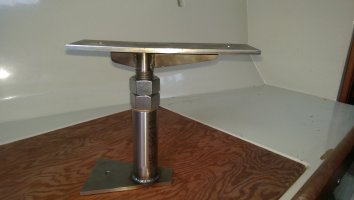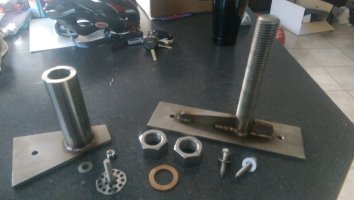I lost a lot of drawings and pictures of Luffalee when our home laptop crashed a few years ago including the drawing for the jack screw. However, the fabricator I worked with preferred a mock up over drawings. The jack screw consisted of two pieces of 1/4" stainless plate, a 1" section of threaded rod, and a tube with a 1" ID (I don't recall what the OD was, but I think the wall thickness was around 1/4"). I used two nuts, one to provide the force and a lock nut so it didn't back off over time. I also added an oil infused brass washer between the tube and the bottom nut.
I used some cheap poplar ply and a dowel to mock up the part. I started by shaping the bottom piece to fit on the keel. The top piece was just a rectangle. I used a spot of hot glue to hold the top piece to the bottom of the sole and keep the bottom piece in place. I measured between the two plates and cut the dowel down to size then hot glued it to both the top and bottom pieces. Then I carefully removed the whole piece and used screws to fasten it together so it wouldn't move while I took it to the fabricator.
The fabricator cut all the pieces to size, faced both ends of the threaded rod and tube, machined the threads off the top of the threaded rod, and welded it all together. They finished it off by deburring everything.
The bottom plate measurement should be failry simple to get by measuring, cutting a template from a piece of paper, then transferring that to the mock up part. The top plate should just require measuring the bottom of the sole where the compression post rests. I made mine removeable by securing with bolts to the bottom of the sole, and a stud epoxied to the top of the keel. If you go this route, make sure you thoroughly wax the bottom of the part before bedding in epoxy and make sure no epoxy goes over the top edge of the bottom plate. It would also help to bevel the sides of the bottom plate, but this would require more work from fabricator and could increase the cost of the part.








